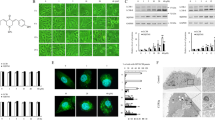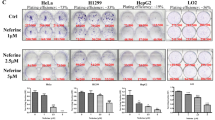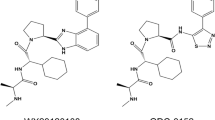Abstract
Killing cancer cells through the induction of apoptosis is one of the main mechanisms of chemotherapy. However, numerous cancer cells have primary or acquired apoptosis resistance, resulting in chemoresistance. In this study, using a novel chalcone derivative chalcone-24 (Chal-24), we identified a novel anticancer mechanism through autophagy-mediated necroptosis (RIP1- and RIP3-dependent necrosis). Chal-24 potently killed different cancer cells with induction of necrotic cellular morphology while causing no detectable caspase activation. Blocking the necroptosis pathway with either necrostatin-1 or by knockdown of RIP1 and RIP3 effectively blocked the cytotoxicity of Chal-24, suggesting that Chal-24-induced cell death is associated with necroptosis. Chal-24 robustly activated JNK and ERK and blockage of which effectively suppressed Chal-24-induced cytotoxicity. In addition, Chal-24 strongly induced autophagy that is dependent on JNK-mediated phosphorylation of Bcl-2 and Bcl-xL and dissociation of Bcl-2 or Bcl-xL from Beclin-1. Importantly, suppression of autophagy, with either pharmacological inhibitors or small interfering RNAs targeting the essential autophagy components ATG7 and Beclin-1, effectively attenuated Chal-24-induced cell death. Furthermore, we found that autophagy activation resulted in c-IAP1 and c-IAP2 degradation and formation of the Ripoptosome that contributes to necroptosis. These results thus establish a novel mechanism for killing cancer cells that involves autophagy-mediated necroptosis, which may be employed for overcoming chemoresistance.
This is a preview of subscription content, access via your institution
Access options
Subscribe to this journal
Receive 50 print issues and online access
$259.00 per year
only $5.18 per issue
Buy this article
- Purchase on Springer Link
- Instant access to full article PDF
Prices may be subject to local taxes which are calculated during checkout







Similar content being viewed by others
References
Seve P, Dumontet C . Chemoresistance in non-small cell lung cancer. Curr Med Chem Anticancer Agents 2005; 5: 73–88.
Hanahan D, Weinberg RA . Hallmarks of cancer: the next generation. Cell 2011; 144: 646–674.
Lonning PE . Molecular basis for therapy resistance. Mol Oncol 2010; 4: 284–300.
Ghavami S, Hashemi M, Ande SR, Yeganeh B, Xiao W, Eshraghi M et al. Apoptosis and cancer: mutations within caspase genes. J Med Genet 2009; 46: 497–510.
Mor G, Montagna MK, Alvero AB . Modulation of apoptosis to reverse chemoresistance. Methods Mol Biol 2008; 414: 1–12.
Ocker M, Hopfner M . Apoptosis-modulating drugs for improved cancer therapy. Eur Surg Res 2012; 48: 111–120.
Kreuzaler P, Watson CJ . Killing a cancer: what are the alternatives? Nat Rev Cancer 2012; 12: 411–424.
Long JS, Ryan KM . New frontiers in promoting tumour cell death: targeting apoptosis, necroptosis and autophagy. Oncogene 2012; 31: 5045–5060.
Galluzzi L, Vitale I, Abrams JM, Alnemri ES, Baehrecke EH, Blagosklonny MV et al. Molecular definitions of cell death subroutines: recommendations of the Nomenclature Committee on Cell Death 2012. Cell Death Differ 2012; 19: 107–120.
Feoktistova M, Geserick P, Kellert B, Dimitrova DP, Langlais C, Hupe M et al. cIAPs block ripoptosome formation, a RIP1/caspase-8 containing intracellular cell death complex differentially regulated by cFLIP isoforms. Mol Cell 2011; 43: 449–463.
Tenev T, Bianchi K, Darding M, Broemer M, Langlais C, Wallberg F et al. The Ripoptosome, a signaling platform that assembles in response to genotoxic stress and loss of IAPs. Mol Cell 2011; 43: 432–448.
Imre G, Larisch S, Rajalingam K . Ripoptosome: a novel IAP-regulated cell death-signalling platform. J Mol Cell Biol 2011; 3: 324–326.
Han J, Zhong CQ, Zhang DW . Programmed necrosis: backup to and competitor with apoptosis in the immune system. Nat Immunol 2011; 12: 1143–1149.
Galluzzi L, Vanden Berghe T, Vanlangenakker N, Buettner S, Eisenberg T, Vandenabeele P et al. Programmed necrosis from molecules to health and disease. Int Rev Cell Mol Biol 2011; 289: 1–35.
Vandenabeele P, Galluzzi L, Vanden Berghe T, Kroemer G . Molecular mechanisms of necroptosis: an ordered cellular explosion. Nat Rev Mol Cell Biol 2010; 11: 700–714.
Lin Y, Devin A, Rodriguez Y, Liu ZG . Cleavage of the death domain kinase RIP by caspase-8 prompts TNF-induced apoptosis. Genes Dev 1999; 13: 2514–2526.
Sun L, Wang H, Wang Z, He S, Chen S, Liao D et al. Mixed lineage kinase domain-like protein mediates necrosis signaling downstream of RIP3 kinase. Cell 2012; 148: 213–227.
Zhao J, Jitkaew S, Cai Z, Choksi S, Li Q, Luo J et al. Mixed lineage kinase domain-like is a key receptor interacting protein 3 downstream component of TNF-induced necrosis. Proc Natl Acad Sci USA 2012; 109: 5322–5327.
Wang Z, Jiang H, Chen S, Du F, Wang X . The mitochondrial phosphatase PGAM5 functions at the convergence point of multiple necrotic death pathways. Cell 2012; 148: 228–243.
Hitomi J, Christofferson DE, Ng A, Yao J, Degterev A, Xavier RJ et al. Identification of a molecular signaling network that regulates a cellular necrotic cell death pathway. Cell 2008; 135: 1311–1323.
Darding M, Meier P . IAPs: guardians of RIPK1. Cell Death Differ 2012; 19: 58–66.
Todde V, Veenhuis M, van der Klei IJ . Autophagy: principles and significance in health and disease. Biochim Biophys Acta 2009; 1792: 3–13.
Mizushima N, Komatsu M . Autophagy: renovation of cells and tissues. Cell 2011; 147: 728–741.
Pattingre S, Tassa A, Qu X, Garuti R, Liang XH, Mizushima N et al. Bcl-2 antiapoptotic proteins inhibit Beclin 1-dependent autophagy. Cell 2005; 122: 927–939.
Notte A, Leclere L, Michiels C . Autophagy as a mediator of chemotherapy-induced cell death in cancer. Biochem Pharmacol 2011; 82: 427–434.
Bonapace L, Bornhauser BC, Schmitz M, Cario G, Ziegler U, Niggli FK et al. Induction of autophagy-dependent necroptosis is required for childhood acute lymphoblastic leukemia cells to overcome glucocorticoid resistance. J Clin Invest 2010; 120: 1310–1323.
Wu WK, Coffelt SB, Cho CH, Wang XJ, Lee CW, Chan FK et al. The autophagic paradox in cancer therapy. Oncogene 2012; 31: 939–953.
Shen HM, Codogno P . Autophagic cell death: Loch Ness monster or endangered species? Autophagy 2011; 7: 457–465.
Srinivasan B, Johnson TE, Lad R, Xing C . Structure-activity relationship studies of chalcone leading to 3-hydroxy-4,3',4',5'-tetramethoxychalcone and its analogues as potent nuclear factor kappaB inhibitors and their anticancer activities. J Med Chem 2009; 52: 7228–7235.
Wei Y, Pattingre S, Sinha S, Bassik M, Levine B . JNK1-mediated phosphorylation of Bcl-2 regulates starvation-induced autophagy. Mol Cell 2008; 30: 678–688.
Christofferson DE, Yuan J . Cyclophilin A release as a biomarker of necrotic cell death. Cell Death Differ 2010; 17: 1942–1943.
Shen S, Kepp O, Michaud M, Martins I, Minoux H, Métivier D et al. Association and dissociation of autophagy, apoptosis and necrosis by systematic chemical study. Oncogene 2011; 30: 4544–4556.
Marquez RT, Xu L . Bcl-2:Beclin 1 complex: multiple, mechanisms regulating autophagy/apoptosis toggle switch. Am J Cancer Res 2012; 2: 214–221.
Salazar M, Carracedo A, Salanueva IJ, Hernández-Tiedra S, Lorente M, Egia A et al. Cannabinoid action induces autophagy-mediated cell death through stimulation of ER stress in human glioma cells. J Clin Invest 2009; 119: 1359–1372.
Xie CM, Chan WY, Yu S, Zhao J, Cheng CH . Bufalin induces autophagy-mediated cell death in human colon cancer cells through reactive oxygen species generation and JNK activation. Free Radic Biol Med 2011; 51: 1365–1375.
Young A, Lyons J, Miller AL, Phan VT, Alarcon IR, McCormick F . Ras signaling and therapies. Adv Cancer Res 2009; 102: 1–17.
Matsuzawa T, Kim BH, Shenoy AR, Kamitani S, Miyake M, Macmicking JD . IFN-gamma elicits macrophage autophagy via the p38 MAPK signaling pathway. J Immunol 2012; 189: 813–818.
Cagnol S, Chambard JC . ERK and cell death: mechanisms of ERK-induced cell death–apoptosis, autophagy and senescence. FEBS J 2010; 277: 2–21.
He W, Wang Q, Xu J, Xu X, Padilla MT, Ren G et al. Attenuation of TNFSF10/TRAIL-induced apoptosis by an autophagic survival pathway involving TRAF2- and RIPK1/RIP1-mediated MAPK8/JNK activation. Autophagy 2012; 8: 1811–1821.
Warmka JK, Solberg EL, Zeliadt NA, Srinivasan B, Charlson AT, Xing C et al. Inhibition of mitogen activated protein kinases increases the sensitivity of A549 lung cancer cells to the cytotoxicity induced by a kava chalcone analog. Biochem Biophys Res Commun 2012; 424: 488–492.
Vanlangenakker N, Vanden Berghe T, Bogaert P, Laukens B, Zobel K, Deshayes K et al. cIAP1 and TAK1 protect cells from TNF-induced necrosis by preventing RIP1/RIP3-dependent reactive oxygen species production. Cell Death Differ 2011; 18: 656–665.
Bertrand MJ, Milutinovic S, Dickson KM, Ho WC, Boudreault A, Durkin J et al. cIAP1 and cIAP2 facilitate cancer cell survival by functioning as E3 ligases that promote RIP1 ubiquitination. Mol Cell 2008; 30: 689–700.
Shiao SL, Ganesan AP, Rugo HS, Coussens LM . Immune microenvironments in solid tumors: new targets for therapy. Genes Dev 2011; 25: 2559–2572.
Wang X, Ju W, Renouard J, Aden J, Belinsky SA, Lin Y . 17-allylamino-17-demethoxygeldanamycin synergistically potentiates tumor necrosis factor-induced lung cancer cell death by blocking the nuclear factor-kappaB pathway. Cancer Res 2006; 66: 1089–1095.
Wang X, Chen W, Zeng W, Bai L, Tesfaigzi Y, Belinsky SA et al. Akt-mediated eminent expression of c-FLIP and Mcl-1 confers acquired resistance to TRAIL-induced cytotoxicity to lung cancer cells. Mol Cancer Ther 2008; 7: 1156–1163.
Klionsky DJ, Abeliovich H, Agostinis P, Agrawal DK, Aliev G, Askew DS et al. Guidelines for the use and interpretation of assays for monitoring autophagy in higher eukaryotes. Autophagy 2008; 4: 151–175.
Acknowledgements
This study was partly supported by grants from NIEHS/NIH (R01ES017328), NCI/NIH (R03CA156301), Chongqing Health Bureau (2012–2–001).
Author information
Authors and Affiliations
Corresponding authors
Ethics declarations
Competing interests
The authors declare no conflict of interest.
Additional information
Supplementary Information accompanies this paper on the Oncogene website
Supplementary information
Rights and permissions
About this article
Cite this article
He, W., Wang, Q., Srinivasan, B. et al. A JNK-mediated autophagy pathway that triggers c-IAP degradation and necroptosis for anticancer chemotherapy. Oncogene 33, 3004–3013 (2014). https://doi.org/10.1038/onc.2013.256
Received:
Revised:
Accepted:
Published:
Issue Date:
DOI: https://doi.org/10.1038/onc.2013.256
Keywords
This article is cited by
-
The romantic history of signaling pathway discovery in cell death: an updated review
Molecular and Cellular Biochemistry (2023)
-
Manipulating PP2Acα-ASK-JNK signaling to favor apoptotic over necroptotic hepatocyte fate reduces the extent of necrosis and fibrosis upon acute liver injury
Cell Death & Disease (2022)
-
Protective properties of heme oxygenase-1 expressed in umbilical cord mesenchymal stem cells help restore the ovarian function of premature ovarian failure mice through activating the JNK/Bcl-2 signal pathway-regulated autophagy and upregulating the circulating of CD8+CD28− T cells
Stem Cell Research & Therapy (2020)
-
RIP1 promotes proliferation through G2/M checkpoint progression and mediates cisplatin-induced apoptosis and necroptosis in human ovarian cancer cells
Acta Pharmacologica Sinica (2020)
-
The molecular machinery of regulated cell death
Cell Research (2019)



